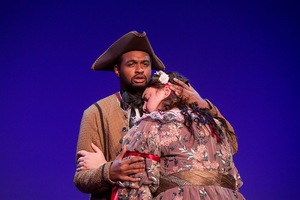The concerti dedicated by J.S. Bach to the Margraf of Brandenburg were probably assembled from music written for Leopold, Prince of Anhalt-Köthen, during Bach’s tenure there (1717-23); it is safe to assume that they were played in relatively intimate spaces, similar to, but not nearly as grand, as the music room in John O’Brien’s “Music House” in downtown Greenville. The hall, created by a large addition to an existing room of the grand old house, is a wonderful performance space seating approximately 75.
The full-house evening began with a wonderful piece of foolishness, with O’Brien in fancy dress approximating Bach’s time, with lace jabot, knee breeches, a black coat trimmed in gold lace, a powdered wig, and a mask affixed with plumes. O’Brien welcomed the company, clad as they were in staid winter coats and such, with “What strange clothes you all have on!”
The opening section was harpsichord solo pieces, the Prelude and Fugue in C minor (Wohltemperirte Clavier, Book I, S.847), two preludes from the Clavierbüchlein vor Wilhelm Friedemann Bach (S.855a in B minor and S.854 in E) that were later incorporated into the Wohltemperirte Clavier, and the Prelude and Fugue in D minor (Book II, S.875). The harpsichord could not have been much more out of tune, an unfortunate circumstance attributable to the numerous cold drafts as each guest came in. The worst problem was the four-foot register, which was not used in the second half of the concert. This familiar music, particularly under the fingers of O’Brien and with the beautiful tone of his Richard Kingston double, never fails to make my heart sing. Such minor slips of the fingers as there were can be blamed on the performer’s need to serve as doorman and cook as well, a situation somewhat similar to Köthen, where Prince Leopold’s orchestra was also his staff of footmen and gardeners. The harpsichord was not ideally placed for the solo pieces; the audience would have benefited if it could have been given the same prominence for its solos as the cello and the violas had in their turn.
The second section was Bach’s Suite in C (S.1009) for cello, performed by Robert O’Brien on a modern cello. O’Brien chose to interpret most of the movements in rhythmically free form, much in the style of some of the preludes in free style by mid-eighteenth century French harpsichordists. I would have preferred a stricter, more dance-like regularity of rhythm, but he made lovely music. The Sarabande was lugubriously slow. O’Brien displayed a sure sense of pitch throughout this difficult work.
All of the instruments this evening were set up as modern strings, with the fat, blowsy, over-rich, over-loud sound that characterizes modern instruments. This was a disappointment, but a small one compared to the wonderful performances that everyone turned in.
Following a sumptuous intermission of hors d’oeuvres and multiple wines, all the cooks and waiters came out of the princely kitchen (literally; the kitchen is the green room) of the Music House to perform Bach’s great tables-are-turned viola joke, Brandenburg VI (S.1051). He could take those footmen’s instruments and make great music. Never mind plusiers instruments, just a couple of violas… and voila, dynamite! The concertino, consisting of Katie Dey and Hillary Herndon, violas, and Robert O’Brien, cello, was a steamroller, baby, that rolled all over the audience! The ripieno of Chris Nunnally and Wendy Bissinger, cellos, Kevin Moll, bass, and John O’Brien, harpsichord, was a perfect backup to the fancy fireworks of the concertino. The first allegro was marked with vigor and finesse; the two violas played their canon as if they were one mind with two ideas constantly intertwining, overlapping, aligning, and diverging again. Dey led, but her partner, Herndon, kept careful eye contact and maintained perfect musicality. There was a little pitch uncertainty in the beginning measure of the Adagio, but that had been neatly resolved before the first viola entrance. How entrancing the first viola makes her siren call, only to be reinforced in her allure by the equally ravishing second. The third movement, also allegro, was a feast, with the radically different timbres of the two violas helping to distinguish the two equally powerful musical lines of the canon.
The ability to see the two performers and to be close enough to hear the two viola parts coming from different places in the room was great! It’s what live music is all about. This wonderful evening was what chamber music is all about. High praise for impresario/soloist John O’Brien and his Music House and for soloists Robert O’Brien, Dey, and Herndon, and for the able assistance of Nunnally, Wissenger, and Moll!











